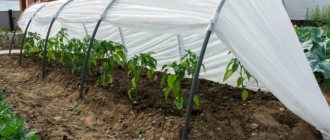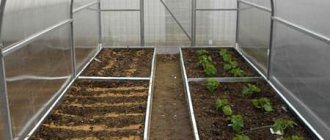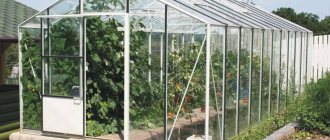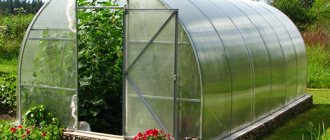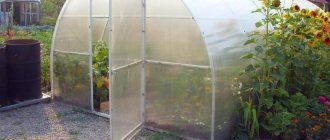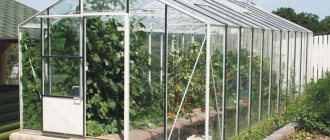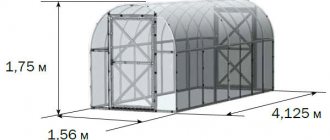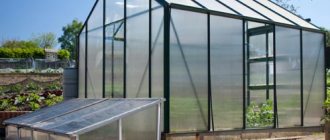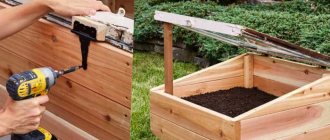What to look for when buying a greenhouse
Have you decided to buy a greenhouse for cellular polycarbonate, but can’t make the final choice?
Let's figure it out together... Frame material
Firstly, you should pay attention to the material of the structure frame. This can be either a galvanized profile pipe or a square profile without galvanization with a cross-section of 20x20 or 25x25 mm; it is not uncommon to find a straight or wave-shaped profile made of galvanized steel.
Let's look at each of them.
So, a square steel profile. The wall thickness varies, depending on the manufacturer, from 0.5 to 2 mm. Before assembly, the profile is primed and coated with powder coating or enamel. But this does not provide complete protection against corrosion. There is a high probability that the frame of the greenhouse will quickly become covered with rust and after each subsequent winter the metal will “bloom” more and more until the profile “rots” completely.
Galvanized steel profile pipe. This material inspires confidence: it is both durable and not subject to corrosion - galvanization saves the day. The wall thickness also ranges from 0.5 to 2 mm. But here you need to “keep your eyes open.” Welded galvanized greenhouses began to appear on the market, the welding points of which are painted over with silver, and instead of a profile seamless pipe there is a pipe with a welded seam (there appears to be a black stripe along the entire length of the pipe). These places will rust within a year or two, don’t fall for the scam! Remember, a real galvanized greenhouse, which is not subject to corrosion, must have no welds. Conscientious manufacturers, where there must be welding between parts, use such elements as “kerchiefs”, “corners”, etc.
And finally,
galvanized steel profile. Standard profile sizes are 44x15 mm and 60x20 mm, wall thickness ranges from 0.7 to 1 mm.
At first glance, this type of profile is inferior to its “brothers” made from pipes in terms of structural strength. In reality this is not always the case. The leading manufacturer of greenhouses in Russia has in its assortment a lancet-shaped greenhouse “Strelka”, the snow load of which is 450 kg/sq.m., and believe me, this is a lot. Distance between arcs
An important aspect when choosing a greenhouse is the distance between the arcs. The optimal distance between the arches is 50 - 75 cm. If the distance between the spans is 1 meter or more, the rigidity of the frame must be increased by using arch reinforcements. They are assembled quite simply, but the strength of the structure increases significantly. For reference, the arc amplifier consists of a horizontal tie and two slopes. It is these slopes that bear the main load.
Many manufacturers of pipe greenhouses make spans of 0.9 m, 1 meter and even 1.2 m without arc amplifiers. But this is very risky - despite the fact that such a design looks impressive, this apparent strength will not protect your coating from breaking. If you reduce spans by using additional arches or reinforcements, this will increase the cost of the structure - not all manufacturers agree to this. Remember, if a pipe structure is cheaper than a galvanized profile structure, it means it is weaker.
If you, as the future owner of a greenhouse, can take care of it in winter, constantly monitor it and, if necessary, remove snow from it, then you can save money and buy a model with a small snow load.
Foundation
Due to their enormous weight, greenhouses made from pipes should be installed on a concrete foundation or timber. It is not difficult to make a foundation from timber, but wood in a greenhouse is short-lived, there is a risk that the tree will rot into dust in 3-4 years, no antiseptic impregnation will save it. A strip foundation is more reliable, it is not afraid of either water or temperature, but this is a rather complicated and labor-intensive task.
Greenhouses made of galvanized steel profiles are lighter in weight than greenhouses made of pipes, so they do not require a foundation; it is enough to bury the special T-shaped ends of the frame in the ground and the structure is ready. But if there is a desire, the frame can be placed on the foundation, so to speak, for reliability.
Coating
How to choose cellular polycarbonate. Let's figure out what it is and, as they say, what it is eaten with.
Cellular polycarbonate is a sheet of several thin plates arranged in parallel and connected by special ribs - jumpers, which determine the strength of the material. According to technical characteristics, polycarbonate is stronger when it has more bridges and weight, and weaker when there is a lack of high-quality binders.
The service life of cellular polycarbonate depends on the raw materials used by the manufacturers (which is very difficult to verify) and on the method of UV protection. Almost all domestic manufacturers make such cellular polycarbonate, which already contains a UV stabilizer. And despite this, for additional guarantee, they produce sheets with protection from ultraviolet radiation in the form of a co-extruded one-sided layer of UV absorber (up to 50 microns thick), which makes it possible to use polycarbonate outdoors for a long time without changing the properties and necessary qualities (up to 15 years).
Carrying out measurements and preparatory work
You don’t have to create a serious project; just draw up and draw a simple diagram on a landscape sheet. On the diagram you should note the main dimensions of the greenhouse. The first thing to indicate is the width and length of the structure. Also on the diagram you need to note the distance between the arches, their number, as well as the depth of immersion of the arches into the soil. If the arches will be attached to wooden walls, you need to immediately think about how to fix them. How to take measurements:
- the recommended width of a greenhouse for tomatoes is 1.5 meters; under such conditions, plants can be planted in 2 rows, with enough space left for care;
- the length of the greenhouse depends on your preferences and free space;
- the distance between the arcs should be from 100 to 150 cm. With large gaps, the covering material will sag and deteriorate;
- to determine the size of the covering material, measure the length of the entire support, add another 10% to the resulting number (for fastening and assembly). It is desirable that the fabric be solid; when sewing the pieces together, damage will remain on it, which will quickly render it unusable.
On a note!
If desired, you can install greenhouses in pairs (with their back walls facing each other), in which case it is necessary to provide for opening them in different directions.
You can calculate the length of the arcs for a greenhouse using geometric formulas or carry out the calculation in an online construction calculator. Some summer residents take measurements in a non-standard way, draw a line on the asphalt equal to the width of the greenhouse, calculate the middle and draw another line upward from it, marking the height of the future structure. By connecting the highest points of the lines, draw an arch, then measure its length with a tape measure. For a greenhouse 6 meters long (the step between the arches is 150 cm), a height and a width of one and a half meters, you will need 5 rods of 386 cm each.
Now we need to determine how to attach the greenhouse arcs. With normal deepening into the soil, you need to add 60 cm to the indicated length; when driving arches into buried wooden pegs, add 20 cm to the length. In the first case, 30 cm of rod on each side of the arch will go into the ground, and in the second - 10 cm in pegs. If the arches are based on pipes, then thinner stakes are driven into the soil, pipes are put on them, then the original length is enough, nothing needs to be added. The situation is similar when attaching arcs to a box; the entire structure is assembled on the surface, only the boundary board is buried in the ground.
How to choose material for arches and shelter
Reinforcement and other metals, including aluminum, are durable, strong, and can be used to make a solid structure by welding. It is permissible to install metal arches into the foundation, thus constructing a permanent, non-removable greenhouse. To form the arcs you will need a pipe bender.
Arches made of metal-plastic, rubber and other types of pipes are easy to install by digging into the ground and just as easy to remove if necessary. To bend pipes, use a heat gun or a special bending device. It is not difficult to bend plastic pipes by hand, but this must be done consistently and very carefully so that the material does not burst at the bend.
You cannot skimp on shelter; material that is too thin or dark will not create the necessary conditions for plants. The canvas should transmit sunlight well during the day, and at night retain all the heat accumulated during the day. The shelter must be strong enough and stable. Taking into account the basic requirements, we will highlight the best options:
- one- or two-layer polyethylene film with a thickness of 150 or 200 km;
- polyethylene film with mesh (reinforced) with a density of up to 100 g/m²;
- polypropylene fabric with a density of up to 60 g/m².
On a note!
Reinforced film is considered the strongest and most reliable covering material; it costs a lot, but is durable.
Experts advise using 2 different covering materials at once, plastic film and non-woven fabric. The first will protect the plants in the spring, and the second will allow maintaining an optimal microclimate inside the structure in the summer, when the only threat to crops is cold nights. Non-woven material ensures normal air circulation and plants are not at risk of overheating.
Preparing tools
When preparing materials, you should rely on the previously drawn diagram of the greenhouse and the features of its installation. If the base is a wooden box, you need to calculate the dimensions of the boards yourself. You should prepare fasteners for the box in advance - self-tapping screws and galvanized corners. The arches are attached to the frame using metal brackets. Tools you will need:
- shovel;
- wood hacksaw;
- screwdriver;
- sharp knife;
- a device for bending pipes or a construction hair dryer;
- hammer.
The covering material can be secured with special latches or the base (rods) can be sewn into the geofabric, thus creating a folding sheet with supports. The second option will require more material. Some summer residents make several windows in such a shelter, so that without the need to remove the entire canvas, plants can be watered and fertilized through the holes. To close the windows, sew in a zipper or textile fastener (Velcro).
Description and Application
Arched greenhouses are arcs installed above the bed and covered with film or non-woven material. The height of the greenhouse can be from 0.5 to 1.3 m, which allows them to be used for different crops. The width is 0.6-1.2 m, and the length depends on the number of arcs and the distance between them. The most popular greenhouses are 4.6 and 8 m long.
A greenhouse made of arcs is used for the following purposes.
- For growing heat-loving plants throughout the season . In this case, it is necessary to select a greenhouse of sufficient height and strength, with strong fastening of the covering material and convenient access to the plants. It is recommended to fence the bed with boards, slate or brick.
Assembling and installing the greenhouse is very simple. Purchased sets of arcs and prefabricated greenhouses are equipped with pegs with which they (the arcs) are stuck into the ground. Non-woven material is placed on top and secured using special clamps or available materials. In some greenhouse models, the arcs are already sewn into the material, which makes installation of the greenhouse easier. The arc installation step depends on the design and is usually 0.5-1.2 m.
Note! The distance between the arcs is chosen so as to prevent sagging of the film. In strong winds, sagging film can damage the tops of plants.
Selection of covering material
For the successful cultivation of vegetables in a greenhouse, the choice of covering material is of no small importance. It must meet the following requirements:
- - It's good to let in the sun's rays.
- — Protect plants from cold air as much as possible.
- - Have sufficient strength for long-term use.
Two types of material have all these qualities:
1. Film.
There is a wide selection of films for greenhouses and greenhouses of different widths, prices and quality on sale. The cheapest option is regular polyethylene film. But its price is the only plus. It is quite thin and can only be used for one season, or at most two.
Reinforced or air-bubble film materials are more durable, although somewhat expensive.
REFERENCE! They are more expensive than regular film, but much more durable.
In addition, due to their thickness, such materials can withstand lower temperatures and better protect plants from adverse conditions.
2. Nonwovens.
They are very popular among vegetable growers.
Any brand of such material varies in thickness. The lightest material is the density of 17g/m2.
The densest thickness is 60 g/m2.
The optimal option for covering greenhouses, combining sufficient density and excellent breathability, is a density of 42g/m2..
ATTENTION! Experienced vegetable growers advise using two materials for arched greenhouses.
The frame is covered with film at the beginning of the season, before planting and when sowing seeds in the ground. The fact is that such a coating helps the soil to quickly warm up and retain maximum heat to improve seedlings.
Then, when the crops have sprouted or the seedlings are ready for planting in the greenhouse, the film covering is replaced with non-woven material. This coating allows the plant to breathe, which means it prevents the plants underneath from overheating. Replacement with non-woven material is carried out when heat sets in.
IMPORTANT! It is not recommended to cover a greenhouse made of arcs with a thin non-woven material, since under the influence of friction it will tear and is unlikely to serve you even until the end of one season.
Industrial Arc Sets
The kits are arches made of insulated wire or pipes bent according to one template. The set usually contains 6 arches, they are designed for a tunnel shelter or a temporary greenhouse 4-6 m long. The dimensions of the arches - width and height - can be different, from 65 to 120 cm. The arches can also be sold individually - in this case, you can complete a set for greenhouse of the required length.
For the manufacture of arcs the following can be used:
- steel wire Ø5 mm in PVC sheath;
- steel tube Ø10-Ø12 mm in PVC sheath
- PVC pipe Ø20-Ø25 mm.
The wire and tube arches are rigid enough to maintain their shape for several seasons. PVC insulation protects them from corrosion, and pins at the ends make it easier to anchor them in the ground. The arcs are simply stuck into the ground to the required depth.
Arcs made from PVC pipes are more flexible, due to this you can adjust the width and height of the greenhouse. To secure it in the ground, you can use special pegs for PVC pipes or cutting reinforcement.
Special clamps are used to attach the covering material to the arches. To hold the canvas on the ground and protect it from the wind, you can purchase a set of pegs and rings. The pegs are stuck into the ground, covered with covering material and clamped with a ring. Covering material, sets of clamps and pegs, as a rule, are purchased separately, focusing on the number and size of the selected arches.
Note! Sets of arcs can be used to make a permanent greenhouse. To do this, it is enough to assemble a frame from boards and bars and attach the arcs to it.
Prices for arches for greenhouses
Making your own arc greenhouse
For a homemade design, make arcs for a greenhouse with your own hands from any plastic pipe with a diameter of 20 mm. An elastic metal rod with a cross-section of up to 10 mm or a flexible hose will do. In the latter version, the strength of the arch is given by reinforcement. To do this, insert a wire with a cross-section of 6 mm or a long rod made of wicker inside the hose.
Making a homemade greenhouse follows the following steps:
- Before making arcs for a greenhouse, you need to decide on their size. The width of the arch is 1.2 m. The height depends on the growing crops. For example, for cucumbers this figure is 80 cm, and for semi-determinate tomatoes - 1.4 m.
- A rectangular box the size of the bed is made from a board or wooden beam. For work it is better to use oak or larch. Such wood is less susceptible to rotting. The optimal height of the sides of the box is 150 mm. The finished frame is installed in place of the future bed.
- Arcs made from plastic pipes are very flexible and can bend in strong winds. Strengthening the frame will help to cope with the problem. Two racks are installed in the center of the ends of the box made of timber with a cross-section of 50x50 mm. They are connected to each other by a board. In the resulting crossbar, holes are drilled with a diameter 2–3 mm larger than the thickness of the arcs.
- Pieces of the required length are cut from a plastic pipe and inserted into each hole of the crossbar. Now all that remains is to bend the arches from them and secure the ends of the pipes to the box. Fixation to the sides of the frame is carried out using clamps screwed with self-tapping screws or perforated metal tape. Alternatively, you can drive pieces of reinforcement into the ground and put arcs on them.
- According to the size of the ends of the frame with an allowance of 200 mm, 2 fragments are cut out of the covering fabric. The material is fixed to the pipe with plastic clamps. Next, a large piece is cut out of the canvas with an allowance of 500 mm to fit the size of the entire greenhouse. The material is laid out on the frame, fixed to the pipes with clamps. The canvas can be additionally nailed to the top wooden crossbar through an overhead lath.
The covering sheet is pressed to the ground with any weight without sharp edges. Otherwise, the material may tear during the wind.
Attention! The cheapest covering material is polyethylene film, but it will last 1 or 2 seasons. The best option is non-woven fabric with a density of 42g/m2.
The video shows the making of a greenhouse:
Arched greenhouses for industrial production - review
The greenhouse kit usually includes arcs, crossbars, pegs for installation in the ground and clamps for covering material, and in some models the canvas itself. A greenhouse, unlike a set of arcs, is designed for a certain length of the bed, and the distance between them cannot be changed. The most common models of industrially produced arched greenhouses are described below.
Greenhouse "Quickly ripened"
Prefabricated greenhouse with a wide variety of arc sizes. The width, depending on the model, can be 1.0 or 1.1 m; height – 1.2 or 1.6 m; length – 3 or 5 m.
The greenhouse kit includes:
- arcs made of steel wire in a PVC sheath, 4 or 6 pcs. depending on length;
- crossbars – 1 or 3 pcs.;
- clamps for attaching material to arches;
- pegs and rings for fastening to the ground.
Purpose
An arched covering greenhouse is used for the following purposes:
- to grow plants that require a large amount of heat for normal development. It is important to provide access to seedlings (it will be inconvenient to enter a low greenhouse), and also to additionally protect the structure on all sides from strong winds and precipitation;
- for hardening off seedlings of cucumbers, tomatoes, bell peppers and other crops that do not tolerate frost and require additional mandatory acclimatization to outdoor temperatures. The greenhouse is placed directly on the bed above the plants and covered to protect the seedlings from bad weather or scorching sun;
- to accelerate the growth of seedlings of radishes, cabbage, herbs and some flowers;
- seeds of carrots, parsnips, parsley also give early shoots under the film. The germination process increases 2 or even 3 times. Before building such a greenhouse, you need to think about where the most suitable place for greenery will be. After it rises above the ground, the arcs will be removed, and the bed will remain unchanged;
- for reliable protection against various types of pests: butterflies, flea flies, carrot and onion flies. In this case, the structure can be assembled and disassembled several times depending on the number of insects;
- to protect strawberries and strawberries from birds, which sometimes spoil the berries or peck them completely. To prevent the strawberries from rotting, the covering material is raised slightly above the ground. This makes it possible to provide a flow of fresh air and create natural ventilation.
To protect the greenhouse from the wind, a durable covering material is used, and low walls made of boards or slate are built above the ground.
DIY arc greenhouse
If you have available materials, it is not at all necessary to spend money on a ready-made greenhouse - you can make it yourself. It is most convenient to make arches from water pipes Ø20 mm. PVC and HDPE pipes, polypropylene and metal-plastic pipes are suitable for the greenhouse. To strengthen the structure, it is recommended to install pipes on a wooden base.
The technology for assembling and installing a greenhouse made of arcs with covering material with your own hands is shown in Table 1.
Table 1. Do-it-yourself greenhouse made of pipes on a wooden base.
Box under the ground
This element is made from boards with a thickness of 20 mm using a fastening system applicable to wood products.
Polycarbonate thickness
The optimal thickness of polycarbonate for frame arched greenhouses is considered to be 4-10 mm, and its density should be at least 0.7 kg/m2.
Which option to choose depends on the climatic conditions in which the greenhouse will be operated:
- a thickness of 4 mm will be sufficient only in areas with a mild climate and little snow;
- in regions where the climate is more severe and a thick snow cover forms in winter, 6 mm polycarbonate is suitable. Sometimes in house-shaped greenhouses two types of panels are combined: for walls - 4-6 mm, for pitched roof - 6-8 mm;
- polycarbonate with a thickness of 8-10 mm is used in greenhouses intended for growing seedlings in cold weather in the middle zone, as well as in the northern regions.
If you want to save money and buy a sheet less than 4 mm thick (even if it is slightly thinner - 3.7 mm), it is strongly recommended not to do this. The plastic covering will not be rigid enough and may not withstand the load of snow and wind.
But you also can’t overdo it. Take into account this fact: the thicker the polycarbonate, the more stiffeners it has and, accordingly, the stronger the sheet. But the less the material transmits light. And for growing light-loving plants, this indicator is very important.
Website about the dacha
Today you can buy anything, and ready-made greenhouses are no exception. Many construction companies offer their services in this area. However, the cost of a finished greenhouse is so high that you can purchase products on the market with a three-year supply. Also, rumors about modified genetic products and how they affect humans are now actively spreading. In this regard, many owners of summer cottages strive to grow their own vegetables. And in order not to spend a lot of money on buying ready-made greenhouses, you can try to build one from old plastic pipes, window frames and pegs. It is worth noting that a carefully made greenhouse will not be inferior in quality and appearance to a new one. In this article we will look at the question of how to make arcs for a greenhouse and what they can be made from.
- How to make plastic arcs for a greenhouse
- How to make steel arcs for a greenhouse
- How to make arcs for a greenhouse from an old hose
The first few arcs will be trial ones. When bending them, it is recommended to mark with a pencil on the jack or adjusting screw the intermediate values of the curvature of the elements.
UV protective layer
Polycarbonate, which is used in outdoor conditions, urgently needs protection from ultraviolet radiation. Under the influence of the sun, the material becomes cloudy, becomes covered with microcracks and gradually crumbles. Therefore, manufacturers apply a special protective coating to polycarbonate.
A material that does not transmit ultraviolet radiation is melted into the top layer of the sheet at the factory. A thin, inseparable film is formed - the human eye cannot see it. Therefore, the UV protected side must be marked.
Be careful when installing polycarbonate on the greenhouse - turn the sheet outward with the intended side. There are options with double-sided UV protection. But for greenhouses this is unnecessary.
Greenhouse or greenhouse?
A greenhouse is a capital, fairly high structure with a door or gate, additional heating for growing plants in protective soil all year round. What is a greenhouse:
- A greenhouse is a small structure to protect seedlings from freezing temperatures.
- The greenhouse is heated by sunlight and the heat released during the decay of humus or manure.
Note. As a rule, greenhouses do not have heating systems or doors. Access via side or top.
- The small area and height of greenhouse structures makes it impossible to grow large adult plants from germination to harvest.
- The main purpose is to obtain seedlings or early greens (see) and radishes, as well as temporary protection of plantings from low temperatures.
- For the most part, greenhouse structures are lightweight, easy to assemble and, if necessary, easily transported. For a simple design, use PVC greenhouse arcs.
It is ease and affordable prices that most land owners focus on. Modern materials and designs made from them come to their aid. Today, PVC is indispensable for setting up a greenhouse on a personal plot.
What are PVC greenhouse arcs?
Greenhouse arcs serve as a rigid frame for stretching and fastening the covering material: or spunbond. In addition, they must be light, transportable and resistant to environmental factors. These requirements are fully met by PVC arcs for greenhouses:
- Polyvinyl chloride is a modern thermoplastic synthetic material, characterized by low toxicity, and is not destroyed by aggressive acidic and alkaline environments.
- Arcs made of polyvinyl chloride (PVC) are very light and convenient for assembling greenhouses of any size. Arcs for a greenhouse in PVC are made either from metal pipes of different diameters protected by a PVC coating or from metal wire braided in PVC.
Note. Not only are they heavier and more durable, but they also come at a higher price.
An important advantage of PVC greenhouse arcs is that they do not need additional painting and can be used year-round, for many years.
Cutting metal-plastic pipe
Metallic profile
An important quality indicator for a greenhouse is its frame. It must be tough and able to withstand any load. As a material for the frame, choose a galvanized metal profile with a square or rectangular cross-section. U-shaped ones will have insufficient rigidity; a greenhouse made from them will not last long.
When choosing a profile for the frame, consider the following characteristics:
- metal thickness - at least 1.2 mm, otherwise there is a high probability that it will bend under high load;
- The cross-section of the frame profile must be at least 20x20 mm. But for the base it is better to use a more durable, rectangular 20x40 mm;
- the profile pipe must be galvanized outside and inside. Other methods of coating are less durable - the metal will quickly begin to rust;
- For a greenhouse it is better to use solid-bent arches. If transportation is difficult, choose composite arches with a small number of joints and strong fastenings of the butt joints.
Preparing the base of the greenhouse
To make the base, boards with a width of 100-150mm and a thickness of 24-40mm are required.
- If you plan to install a greenhouse for a long period of use, it is better to use a 100x100mm wooden beam as a base.
- The material is sawn to size and joined together using fastening materials in the form of a rectangle.
Greenhouses made of cellular polycarbonate
Literally immediately with the advent of cellular polycarbonate, an interesting proposal appeared - arched greenhouses coated with cellular polycarbonate. These ideas came to Russia from France and Germany. It was there that, for the first time in the mid-seventies of the last century, the idea of promising protected ground structures with an unusual and fashionable coating was demonstrated.
This idea was first picked up by residents of the Netherlands (Holland). They built such greenhouses and grew fruits and vegetables unusual for northern territories in limited areas. No one in those years (1980...1995) expected that the Dutch would be able to grow watermelons and melons, as well as seedless grapes, which are cultivated in countries with hot climates.
A semicircle was bent from profile pipes of rectangular and square cross-section. It served as a support for the greenhouse. Several similar curved elements are installed along one axis so that the semicircles form a single spatial semi-cylinder. It was covered with cellular polycarbonate on top. All that remained was to design the entrance and the opposite end. As a result, with a small amount of labor and materials, an excellent arched greenhouse was obtained.
General view of a typical arched greenhouse made of bent profile with a cellular polycarbonate coating. Quite simple and durable design.
The material turned out to be quite technologically advanced. Today, millions of similar greenhouses have been installed throughout the country. They grow hundreds of thousands of tons of nightshade and other crops.
Problems of arched greenhouses
The old proverb: “What is good for a Russian is death for a German,” worked the other way around. In the conditions of Germany, France, and Holland, the phenomenon called “ice rain” did not appear. In Russia, this phenomenon has been recorded annually since 2010. Rain falls and freezes within seconds on exposed surfaces, forming a crust of ice. Snow falls on top, which accumulates on the roof of the greenhouses in a thick layer, without sliding down. The rolling angle at the apex is zero.
Over most of the roof, the slope angle increases slowly. As a result, a statistical load of 200 kg per 1 square meter presses precisely on that same meter of width along the entire length of the greenhouse. In the winter of 2016-17, the snow load exceeded statistical data; in some areas it amounted to 270...300 kg per sq.m. The result was disastrous for many arched greenhouses. The roof caved in.
The photo demonstrates what many summer residents saw in the spring. The roof of their greenhouses could not withstand the snow load and collapsed under the pressure of the snow.
Now many manufacturers, who swore and swore that their products would last twenty years or more, are engaged in repairs. Many have already closed their doors so as not to be liable for the guarantees that they generously distributed, focusing on the German or Dutch experience. The strength of the arched vault turned out to be insufficient for the conditions of Russia.
How can greenhouses be strengthened so as not to be afraid of snow?
Cellular polycarbonate is an excellent material, but the design must be different. The greenhouse vault cannot be set to zero degrees. A gable roof or a peaked vault should be used. The picture below shows the desired polycarbonate greenhouse vault. The costs of its production will be higher than with standard production of an arched structure. It will take more metal and polycarbonate, but this is the product that will serve for those same twenty years or more in the conditions of central Russia.
General view of greenhouses now offered by Moscow companies with polycarbonate coating. The peaked vault is visible at an acute angle. Slope angle more than 60°
Ways to save polycarbonate greenhouses from excess snow load in winter
An acceptable option is to manufacture greenhouses with a pitched roof.
- Even a pitched roof with a pitch angle greater than 12° will remove snow.
- A gable roof has a very short slope, usually about 1700 mm.
- Jib struts should be installed inside the structure to strengthen the fastening of the arch, which will further strengthen the frame.
If you install an autonomous heater inside, then it is enough to connect it several times during the winter so that water forms in the lower layer of snow. It will serve as a lubricant for the snow, and it will roll down. In some regions, recommendations were sent to residents of villages using arched greenhouses. They suggested the following.
- Place a small barrel inside the greenhouse.
- Prepare the lid to completely cover the barrel.
- Light a fire inside.
- Cover the barrel with a lid.
- Close the greenhouse doors.
- Control the smoldering of the wood inside the barrel to prevent open fire from escaping.
- Monitor snow removal from the roof of the greenhouse.
These recommendations are common sense. You just need to have a long-burning stove, inside of which the fuel does not burn, but slowly smolders.
"Comfort"
Mini-greenhouses for summer cottages “Comfort” have been produced since 2012 by the company “Udachny Sezon”. This is a product that has an ideal price-quality ratio. Low cost, compactness and durability are the main advantages and distinctive features of a mini-greenhouse, which can be purchased in two sizes at once. The length of the structure is 3 or 5 meters - an excellent solution for one ridge. Height 55 centimeters and width 50 cm - dimensions ideal for seedlings. Before planting in open ground or in a greenhouse, plants will be comfortable and spacious in such a mini-greenhouse. The advantages of the design also include the use of high-quality covering material. Agrotex with a density of 60 g/m² is an ideal option for early planting. For example, in greenhouses intended for growing cucumbers, tomatoes and peppers, material of lower density is used, since there are no strong temperature changes during the growing period of these crops. By the way, the service life of agrotex is at least three years, so you do not have to change it every season. And this is a great saving for the family budget.
You don’t have to assemble such a mini-greenhouse with your own hands.
It is a non-demountable structure made of covering material and arcs. The latter are made of high quality stainless steel. It does not corrode and is not afraid of exposure to the external environment. No additional components are required. metal arcs easily penetrate the soil and securely fix the structure. In such a covered greenhouse you can grow greens, strawberries, strawberries and cabbage. Of course, these crops can also be grown in open ground. But using a mini-greenhouse is a great opportunity to enjoy your harvest a few weeks earlier. From seven greenhouses with covering material, you can easily choose the appropriate option. In this case, you should take into account the purpose of the structure, the type of vegetable crops that are planned to be grown in the mini-greenhouse, as well as weather conditions.
Reliable fastenings and window
It is important to ensure regular ventilation in the greenhouse. This will avoid condensation, promote good pollination of plants, and prevent sudden changes in day and night temperatures. The minimum requirement for normal ventilation is the presence of at least one window in the greenhouse. It should be located on the end side of the greenhouse - opposite the door, and open to at least an angle of 50-55 degrees.
Doors and windows must be securely attached to the frame using special fittings. It is worth installing special clamps that will prevent an open door or window from slamming in case of gusts of wind. And due to the ability to adjust the size of the gap, they will provide good ventilation without a strong draft.
If the greenhouse is more than 6 meters in length, it is recommended to additionally install vents on the roof or on the sides of the structure. The side ones should be located at ⅔ the height of the greenhouse.
It is recommended to install mechanisms for automatic opening on the door and vents. The automation operates at a given air temperature and ensures regular ventilation. When choosing such accessories, you should give preference to products from well-known manufacturers.
With these simple tips, you can easily select the best greenhouse for your garden on 220.lv.
Source of the article: https://prozvety.ru/poleznaya-informatsiya/pravilno-vybrat-teplitsu-iz-polikarbonata
“Clover S”
New from the company of the same name. A greenhouse with iron arcs covered with polyvinyl chloride braid. Available for sale in several sizes with a height of 65 or 120 cm. Can be used for growing vegetables, seedlings, and rooting seedlings. Deciding which is better - covering material or greenhouse film - is, of course, up to you. Covering greenhouse “Clover S” is supplied for sale with film or agrofibre. Arcs are sewn into both materials, which provides additional ease of use. “Clover C” is equipped with pegs for the side and end parts.
"Guarantee"
An accordion greenhouse with a dense and breathable covering material “Garant” is time-tested strength. The main advantage of this design is that it is reinforced with transverse arches. It will withstand the strongest winds. You can install a covering greenhouse of this type even in the steppe. Rest assured, this design will not let you down in any weather conditions.
You can buy the “Garant” greenhouse in the online store. It is available in two sizes - 3 and 5 meters. Its width is designed for the ridge. This will provide convenient weeding, watering and access to the structure from both sides.
In combination with green plants and bright fruits, this design looks great. The “Garant” greenhouse is reinforced with transverse arcs. The structure comes complete with modern covering material Agrotex. It contains UV stabilizers that can reliably protect your plants. This component is also a guarantee of the durability of the material. With proper use and proper storage, it will last you at least three years. The density of Agrotex used for Garant greenhouses is 50 g/m².
It is worth noting that many people strive to buy a polycarbonate greenhouse or make one in order not to make daily efforts to open and close the structure. The covering material that comes with the “Garant” greenhouse consists of two parts connected to each other with a zipper. This allows you to easily operate the structure.
